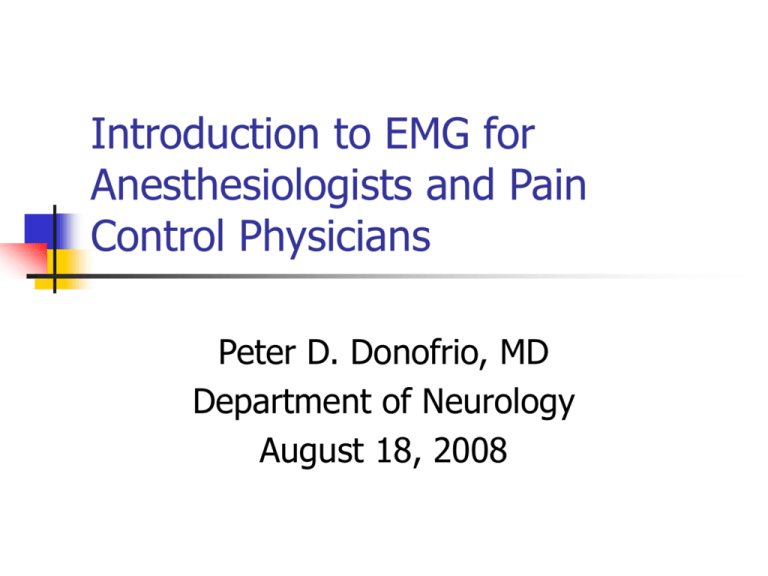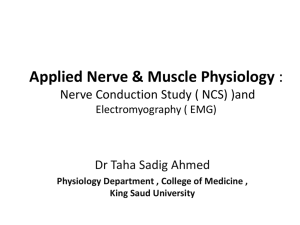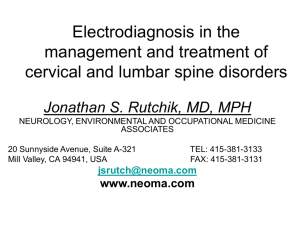Introduction to EMG
advertisement

Introduction to EMG for Anesthesiologists and Pain Control Physicians Peter D. Donofrio, MD Department of Neurology August 18, 2008 EMG and Nerve Conduction Studies An extension of the Physical Examination Quantitates nerve and/or muscle injury Provides Useful Data Regarding Nerve Injury Site Type Severity Duration Prognosis Importance of EDX Studies Diagnosis Localization Assist in further testing (i.e. identify potential biopsy sites, imaging studies, spinal fluid analysis, blood work) Prognosis Use in Research NCSs and EMG Points to Remember NCSs and EMG: assess physiology of nerve and muscle Not all radiculopathies are structural Neurologic consultation is best obtained before the testing is ordered If NCSs and EMG normal or non-contributory, justification for neurologic consultation is greater than before testing Goals of EDX Testing Localization Muscle Fiber type Severity NMJ Nerve Pathology Adapted from fig 1-2, Preston and Shapiro Anterior Horn Temporal course When to order NCSs and EMG Mononeuropathy Mononeuropathy Multiplex Radiculopathy Plexopathy (Brachial or Lumbosacral) Anterior Horn Cell Disorders Diffuse neuropathies Cranial neuropathies Neuromuscular Junction Disorders Myopathy When Not to order NCSs and EMG Central Nervous System Disorders (Stroke, TIA, Encephalopathy, spinal cord injury) Multiple Sclerosis Total body fatigue, fibromyalgia Joint pain Unexplained weakness (without a neurologic consultation) Failed back, S/P multiple neck and low back surgeries In place of a neurologic consultation Types of nerve conduction studies Sensory: typically antidromic Typical nerves examined: Sural, ulnar, median, occasionally radial or superficial peroneal Sensory NCS Parameters Onset and peak latencies Conduction velocity determined by velocity of a very few fast fibers Amplitude determined by the number of large sensory fibers activated Normal Median Sensory Study 1 msec/div Latency CV (msec) (m/s) Wrist-D2 2.2 58 Amp (uV) 44.1 Motor NCS Parameters Distal Latency Amplitude determined by conduction velocity of the nerve, neuromuscular junction & muscle determined by number of muscle fibers activated Proximal conduction velocity determined by conduction velocity of the fastest fibers Motor Nerve Conductions Vital part of EDX as this important for identifying demyelination, compression Need to do proximal and distal studies to evaluate for conduction velocity, conduction block, temporal dispersion Typical nerves: ulnar, median, peroneal, tibial. Less common: radial, femoral, phrenic, spinal accessory, facial Normal Median Motor Study DL CV Amp (msec) (m/s) (mV) Wrist-APB 3.2 15.0 Elbow-Wrist 55 14.8 What is Peripheral Neuropathy? Nerve conduction responses after injury F-waves and H-reflex Useful for identifying proximal segmental demyelination Can only be done when motor amplitude is > 1 mV Extremely heightdependent F Waves: Normal Median Needle Electromyography: Techniques Needle electrode is inserted into the muscle Multiple muscles are accessible for examination Combination of muscles tested Needle is disposable, single use Dependent upon clinical question Level of discomfort is mild Needle Electromyography: Data Insertional Activity Spontaneous Activity Motor Unit Configuration Motor Unit Recruitment Interference Pattern Needle Electromyography: Data Motor Unit Configuration Motor Unit Recruitment Single motor unit: A motor axon and all its muscle fibers Motor Unit Configuration: Amplitude, Duration, Morphology Muscle is volitionally activated at different force levels Needle recording properties enable assessment of single MUs Pattern of motor unit activation with increasing volitional activation Interference Patterns Motor unit pattern with full voluntary activation EMG: Spontaneous Activity Fibrillation Potentials Positive Sharp Waves EMG: Spontaneous Activity Fasciculation Potential EMG: Neurogenic Motor Unit 10 msec/div, timebase 2MV/vertical segment EMG Motor Unit Changes Common Mononeuropathies Median at the Wrist (CTS) Ulnar at the Elbow (Tardy Ulnar Palsy) Peroneal Palsy at the Fibular Head Case 1 63 year old woman Numbness, tingling, pain of entire right hand X 4 months Awakens her at night. Drops objects from right hand Works as sander in furniture factory. Borderline diabetic Examination: Decreased cold entire right hand, normal strength, positive Tinel’s right wrist, normal reflexes in the RUE Carpal Tunnel Syndrome Atrophy of APB Muscle Dawson,Hallett, Millender, 1990 Median Nerve Innervation of the Hand and Sensory Loss Kopell, Thompson, 1963 Carpal Tunnel Syndrome X-Section View of Wrist Kopell, Thompson, 1963 Case 1 continued Sensory Conduction Studies Side Nerve Recording Site Right Median Digit 2 Right Ulnar Digit 5 Right Radial Dorsum thumb Stimulation site Wrist Latency (ms) Amplitu Cond. de Velocit (mcv) y (m/s) 4.2 12 (<3.5) (>22 ) Wrist 2.9 21 (<3.2) (>10 ) Dorsum 1.9 23 forearm (<2.0) (>21 Case 1 continued Motor Conduction Studies Side Nerve Recordi ng Site Right Media APB n Stim. Site Latency (ms) Ampl. (MV) Velocity (m/s) F-wave (ms) Right Media APB n Wrist 6.0 2.9 36 (<4.0 (>4.0 ) ) Ante. 2.7 47 Fossa (>49) Right Ulnar ADM Wrist Right Ulnar ADM 3.1 7.3 30.3 (<3.4 (>6.0 ) ) B. 6.8 51 Elbow (>49) Ulnar Neuropathy Claw Hand Haymaker, Woodhall, 1953 Ulnar Neuropathy Sensory Loss, Nerve Innervation Kopell, Thompson, 1963 Common Peroneal Injury Right Foot Drop and Sensory Loss Haymaker, Woodhall, 1953 Length Dependent Motor and Sensory Polyneuropathy Schaumburg 1983 Plexopathy: Selected Etiologies Compression (CABG) Inflammatory (Parsonage-Turner Syndrome) Radiation Injury (Radiotherapy) Traumatic Injury (Traction, laceration, missile) Ischemia (Diabetic amyotrophy) Guillain-Barre Syndrome Conduction Block Dermatomyositis Eyelid and Facial Rash Dermatomyositis Hand Rash Model of Neuromuscular Junction Myasthenia Gravis Repetitive Nerve Stimulation Single Fiber EMG Myasthenia Gravis Lambert-Eaton Syndrome Repetitive Nerve Stimulation What to Expect From an EMG Report A clinically and physiologically relevant interpretation/diagnosis An outline of the localization, severity, and acuity of the process Notation of other diagnoses that are detected/excluded Explanation of any technical problems Summary: Utility of EMG/NCS Highly sensitive indicator of early nerve injury Detects dynamic and functional injury missed by MRI Provides information regarding chronicity of nerve injury Provides prognostic data Highly localizing Clarifies clinical scenarios when one disorder mimics another Identifies combined multi-site injury, avoiding missed diagnoses Identifies more global neuromuscular injury with focal onset Provides longitudinal data for charting course, response to therapy ** All dependent on a reliable laboratory with full repertoire of techniques EMG “Pearls” Electrodiagnostic studies are a supplement to, and not a replacement, for the history and physical examination Electrodiagnostic results are often timedependent Electrodiagnostic studies are not “standardized” investigations and may be modified by the practitioner to answer the diagnostic question





